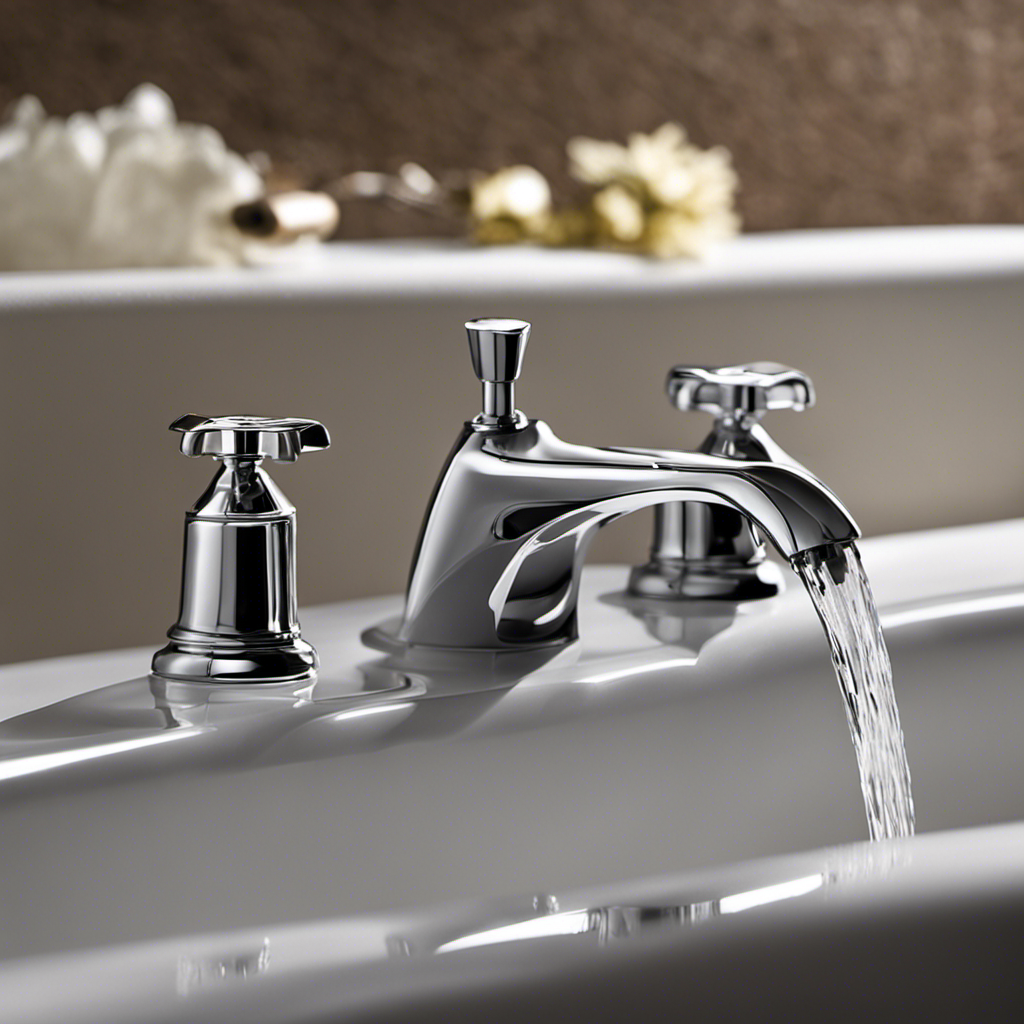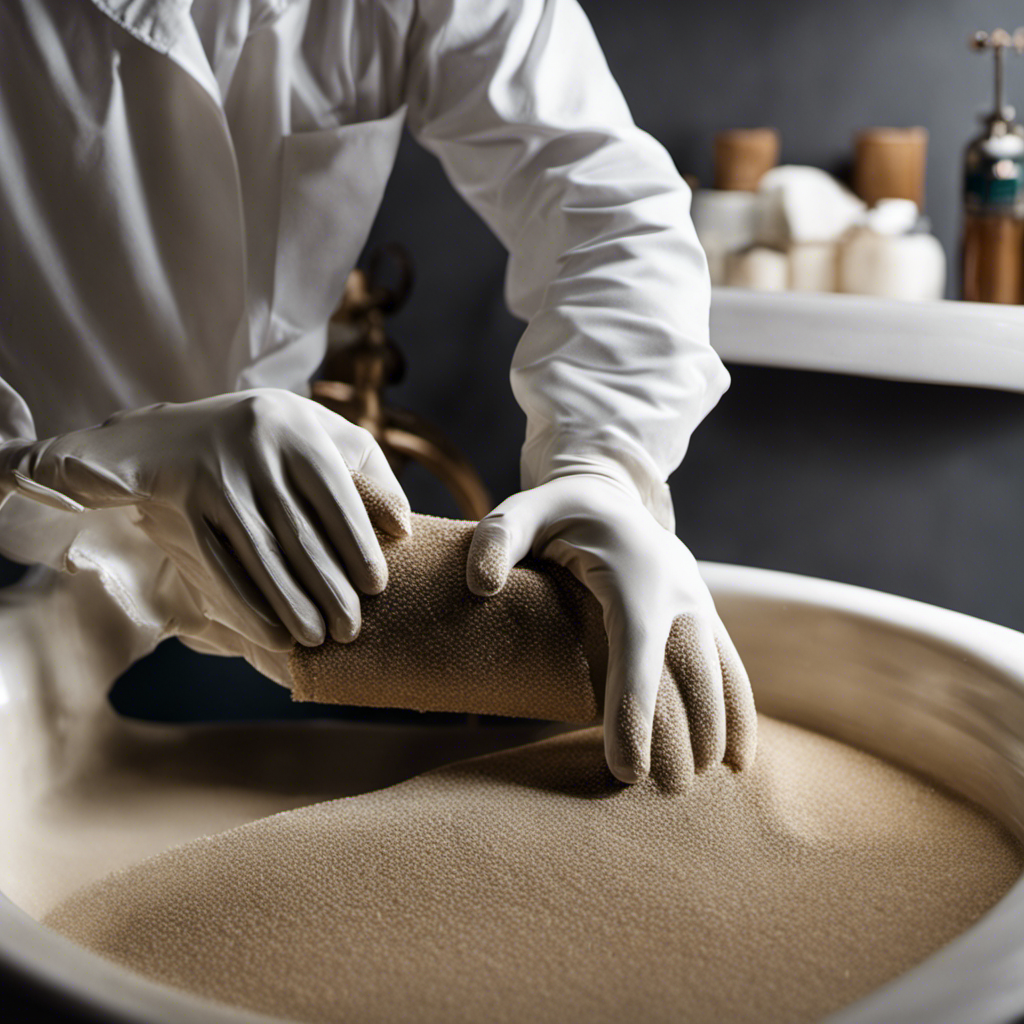Are you tired of the constant drip, drip, drip of your leaking bathtub faucet? Don’t worry, help is here!
In this article, we will guide you through the step-by-step process of repairing your faucet. By following our technical and detailed instructions, you’ll be able to:
- Identify the source of the leak
- Turn off the water supply
- Inspect and clean the cartridge or valve
- Adjust the water flow and temperature
Say goodbye to wasted water and say hello to a properly functioning faucet!
Key Takeaways
- Turning off the water supply is an important first step in repairing a leaking bathtub faucet.
- Preventing further water damage involves cleaning the area around the faucet and applying a waterproof sealant.
- Cleaning, replacing, and checking components such as the faucet handle, cartridge, valve, O-rings, and seals is necessary for fixing the leak.
- Reassembling the faucet and ensuring proper alignment of components is crucial before turning the water supply back on.
Identifying the Source of the Leak
You need to start by checking where the leak is coming from. Identifying the source of the leak is crucial to prevent further damage and mold growth.
There are two options you can consider: DIY or hiring a plumber. If you choose to DIY, begin by turning off the water supply to the bathtub. Then, remove the faucet handle and inspect the cartridge or valve for any signs of damage or wear. If you notice any issues, you can replace the faulty parts or tighten any loose connections.
However, if you’re not confident in your plumbing skills, it’s advisable to hire a plumber. They have the expertise to accurately identify and fix the source of the leak, ensuring a proper repair and reducing the risk of mold growth.
Turning off the Water Supply
To effectively address a leaking bathtub faucet, it is crucial to first shut off the water supply. This action will prevent further water damage and enable you to work on the repair without any complications.
Proper technique is of utmost importance when turning off the water supply to ensure that it is done correctly and efficiently.
Shutting off Water Supply
First, make sure that the water supply to the bathtub faucet is shut off completely. This is an important step to prevent further water damage and ensure a successful repair.
To shut off the water supply, locate the shut-off valve near the bathtub. It is usually located under the sink or in the basement. Turn the valve clockwise until it is fully closed. This will stop the flow of water to the faucet.
Once the water supply is shut off, you can proceed with repairing the leaking faucet. Checking the water pressure is also crucial to prevent corrosion and further leaks. You can use a water pressure gauge to measure the pressure and make necessary adjustments if needed.
Preventing Further Water Damage
To prevent any additional water damage, it’s important to ensure that the water supply to the bathtub faucet is shut off completely. Once the water supply is turned off, you can focus on preventing further water damage by implementing effective waterproofing techniques.
One of the most common methods is using sealant to create a watertight barrier around the faucet. Start by cleaning the area around the faucet thoroughly to remove any dirt or debris. Then, apply a waterproof sealant, such as silicone, around the base of the faucet, making sure to cover any gaps or cracks. Smooth out the sealant with your finger or a caulking tool for a neat finish.
Allow the sealant to dry completely before turning the water supply back on. This simple yet effective technique will help prevent any future leaks and water damage.
Importance of Proper Technique
One important thing to remember is ensuring that you use the proper technique when applying the waterproof sealant around the base of the faucet. This step is crucial to prevent any further leakage and water damage in your bathtub.
When applying the sealant, make sure to clean the area thoroughly and remove any old sealant or debris. Next, apply a thin and even layer of sealant around the base, making sure to cover the entire area. Avoid applying too much sealant as it may not adhere properly. Additionally, be careful not to smear the sealant onto other surfaces.
These common mistakes can compromise the effectiveness of the sealant and lead to future leaks. By using the proper technique, you can ensure a watertight seal and maintain the integrity of your bathtub faucet.
Removing the Faucet Handle
When it comes to removing the faucet handle, there are several techniques you can use depending on the type of handle you have. Common handle issues include loose handles, stuck handles, or handles that are difficult to turn.
To successfully remove the handle, you will need a few tools such as a screwdriver, pliers, and an Allen wrench, depending on the type of handle you have.
Handle Removal Techniques
The first step in removing the handle is to locate the set screw. This screw is usually found on the underside of the handle or concealed behind a decorative cap. Once you have located the set screw, use an appropriate screwdriver to loosen and remove it. After the screw is removed, you can proceed to remove the handle by gently pulling it away from the faucet. It may require some wiggling or twisting to loosen it from the stem. If the handle is stuck, try using a handle puller tool to aid in its removal. Once the handle is removed, you can now proceed with handle replacement or further troubleshooting techniques.
| Step | Instructions | Tools Required |
|---|---|---|
| 1 | Locate the set screw | Screwdriver |
| 2 | Loosen and remove the set screw | Screwdriver |
| 3 | Gently pull the handle away from the faucet | N/A |
| 4 | Use a handle puller if necessary | Handle puller tool |
Now that you have successfully removed the handle, let’s move on to discussing common handle issues.
Common Handle Issues
Now that you’ve learned how to remove the handle, let’s explore some common handle problems that you may encounter while troubleshooting faucet issues.
One common issue is a loose handle, which can be caused by a worn-out or broken screw. In this case, you’ll need to tighten or replace the screw to secure the handle properly.
Another common problem is a stiff or difficult-to-turn handle, often caused by mineral buildup or a worn-out cartridge. To fix this, you can try cleaning the handle and cartridge with a vinegar solution or replace the cartridge altogether.
By addressing these common handle issues, you can restore the functionality of your leaking bathtub faucet.
Now, let’s move on to the next section where we’ll discuss the tools required for handle removal.
Tools for Handle Removal
To remove the handle, all you need are a pair of pliers and a screwdriver. Handle removal techniques vary depending on the type of faucet you have.
For a single-handle faucet, start by turning off the water supply. Then, locate the set screw on the handle and use a screwdriver to remove it. Once the screw is removed, use the pliers to grip the handle firmly and pull it straight out.
If you have a double-handle faucet, the process is similar. Start by turning off the water supply and removing the set screw. Then, use the pliers to gently wiggle the handle until it loosens and can be pulled off.
If you encounter any issues during handle removal, such as a stuck handle or stripped screw, consult a professional for further troubleshooting.
Inspecting the Cartridge or Valve
First, you’ll want to turn off the water supply to the bathtub faucet before inspecting the cartridge or valve.
To begin, remove the handle by locating the screw underneath the decorative cap or cover plate. Use a screwdriver to loosen and remove the screw, allowing you to pull off the handle.
Once the handle is removed, you will have access to the cartridge or valve. Inspect the cartridge for any signs of damage or wear, such as cracks or leaks. If necessary, replace the cartridge by unscrewing it and installing a new one. Be sure to follow the manufacturer’s instructions for proper installation.
If the issue lies with the valve, it may need to be repaired or replaced by a professional plumber.
Regular handle maintenance and prompt cartridge replacement can help prevent further leaks and ensure the proper functioning of your bathtub faucet.
Cleaning or Replacing the Cartridge or Valve
Once you’ve inspected the cartridge or valve, you can clean or replace it if necessary. Cleaning the cartridge or valve is a crucial step in repairing a leaking bathtub faucet.
To clean the cartridge, start by removing it from the faucet body. Use a soft brush or cloth to remove any dirt or debris that may have accumulated on the cartridge. If the cartridge is heavily clogged or damaged, it may be necessary to replace it.
To replace the cartridge, remove the old one and insert the new one in its place. Make sure to align it properly and secure it tightly.
Cleaning the valve is also important. Use a brush or cloth to remove any dirt or buildup from the valve. If the valve is damaged beyond repair, it may need to be replaced as well.
Checking the O-Rings and Seals
Check the O-rings and seals for any signs of wear or damage. These small components play a crucial role in preventing leaks in your bathtub faucet.
To ensure a successful repair, follow these steps:
- Inspect the O-rings and seals closely for any cracks, tears, or distortion.
- Look for signs of wear, such as flattened or compressed areas on the O-rings.
- Check for any debris or mineral buildup on the seals that could affect their effectiveness.
- Pay attention to any leaking or dripping around the O-rings and seals, as this indicates a need for replacement or repair.
Reassembling the Faucet
To ensure a properly functioning faucet, it is crucial to tighten any loose parts. Begin by using a wrench or pliers to tighten the retaining nuts, ensuring a secure connection.
Additionally, proper alignment of the various faucet components is essential for optimal performance. Make sure all parts are properly aligned and seated in their respective positions before reassembling the faucet.
Tightening Loose Faucet Parts
You’ll want to start by tightening any loose faucet parts to fix the leaking bathtub faucet. Here’s what you need to do:
-
Inspect the handle: Check if the handle is loose or wobbly. If it is, use a screwdriver to tighten the screws or bolts holding it in place.
-
Check the valve stem: The valve stem is responsible for controlling the water flow. If it’s loose, use an adjustable wrench to tighten the packing nut around the stem.
-
Secure the mounting nut: The mounting nut connects the faucet to the sink or countertop. If it’s loose, use a basin wrench to tighten it securely.
-
Inspect the cartridge: Some faucets have cartridges that control the water flow. If it’s loose, remove it and reinsert it properly, making sure it’s aligned correctly.
By ensuring that all the faucet parts are properly tightened, you can address the leaking issue.
Now, let’s move on to the next step of ensuring proper alignment.
Ensuring Proper Alignment
Now that you have tightened the loose parts of your bathtub faucet, it is important to ensure proper alignment for a long-lasting and leak-free solution. Proper installation and maintenance techniques are crucial in achieving this.
To ensure proper alignment, follow these steps:
-
Start by turning off the water supply to the faucet.
-
Carefully remove the faucet handle and any decorative caps or covers.
-
Examine the cartridge or valve assembly for any signs of wear or damage. If necessary, replace it with a new one.
-
Align the cartridge or valve assembly correctly with the faucet body, ensuring that all components fit snugly together.
Testing for Leaks
If there’s a leak, you can easily test for it by turning on the faucet and checking for any water dripping from the spout or handles. To ensure accurate testing, follow these steps:
-
Visual Inspection: Examine the faucet for any visible signs of leaks, such as water stains or puddles around the base.
-
Pressure Testing: Increase the water pressure by turning the faucet handle to the maximum setting. Observe if water starts seeping from the joint connections or other areas.
-
Dye Testing: Add a few drops of food coloring into the faucet’s water source and let it run for a few minutes. If colored water appears anywhere other than the spout, there is a leak.
-
Paper Test: Place a sheet of paper under the faucet and leave it for a few hours. If the paper becomes wet, it indicates a leak.
Adjusting the Water Flow and Temperature
To adjust the water flow and temperature, simply turn the handle clockwise or counterclockwise until you achieve your desired settings.
Adjusting the water pressure is crucial to ensure a comfortable and efficient bathing experience. If the water pressure is too low, you can increase it by turning the handle clockwise. On the other hand, if the pressure is too high, turning the handle counterclockwise will reduce it.
Maintaining water temperature is equally important. By turning the handle to the left, you can increase the temperature, while turning it to the right will decrease it.
Remember to make small adjustments to find the perfect balance between water flow and temperature, ensuring a pleasant and enjoyable bathing experience.
Additional Tips for Preventing Future Leaks
For better prevention of future leaks, you should regularly check the connections and seals in your bathtub faucet. This is an essential step in preventive maintenance to ensure that your faucet remains in good condition and operates efficiently.
By performing these simple DIY repair techniques, you can save yourself from the hassle and expense of dealing with a leaking faucet. Here are some tips to help you keep your bathtub faucet leak-free:
-
Inspect the connections: Check the nuts and bolts that secure the faucet to the plumbing pipes. Tighten any loose connections to prevent water from seeping through.
-
Examine the seals: Look for any signs of wear or damage on the seals around the faucet handles and spout. Replace any worn-out seals to maintain a watertight seal.
-
Clean the aerator: Over time, mineral deposits can build up in the aerator, causing reduced water flow and potential leaks. Remove the aerator and clean it thoroughly to prevent blockages.
-
Be mindful of water pressure: Excessive water pressure can strain the faucet’s components, leading to leaks. Consider installing a pressure regulator to prevent damage and leaks caused by high water pressure.
Seeking Professional Help if Necessary
Seeking professional assistance can provide you with expert advice and solutions if you are unable to resolve the issue on your own. While attempting DIY repair options can be cost-effective and satisfying, sometimes the problem may require specialized knowledge and tools.
In such cases, it is wise to consult a professional plumber who can accurately diagnose the problem and offer effective solutions. Leaking bathtub faucets can be caused by various issues, such as worn-out washers, faulty valves, or damaged O-rings.
A professional plumber will have the expertise to identify the root cause and provide a long-lasting fix. Additionally, seeking professional advice can save you time and money in the long run, as they can offer valuable insights and prevent further damage to your plumbing system.
Frequently Asked Questions
Can I Use Any Type of Cleaning Solution to Clean the Cartridge or Valve?
Yes, you can use various cleaning solutions to clean the cartridge or valve. However, it’s important to choose the right one for your specific faucet type. Follow proper cleaning techniques to ensure effective and safe results.
How Long Does It Typically Take to Reassemble the Faucet?
Reassembling the faucet can take a bit of time, but don’t fret! Follow these troubleshooting tips for a smoother process. Now, let’s get to work and fix that leaking bathtub faucet!
Can I Adjust the Water Flow and Temperature Separately?
Yes, you can adjust the water flow and temperature separately on most bathtub faucets. To do this, locate the handles or knobs and turn them to achieve your desired pressure and temperature. If you’re experiencing any issues, troubleshooting common faucet problems may help.
Are There Any Specific Tools I Need to Remove the Faucet Handle?
To remove the faucet handle, you’ll need a few necessary tools. Start by locating the set screw and using an Allen wrench to loosen it. Then, gently pull the handle off.
What Are Some Signs That Indicate I Should Seek Professional Help for Repairing My Leaking Bathtub Faucet?
If you’re wondering when to call a plumber for a leaking bathtub faucet, look for signs like constant dripping, high water bills, or difficulty turning the handle. These indicate a more serious problem that requires professional help. Assess the severity by checking for water pooling or damage.
Conclusion
In conclusion, tackling a leaking bathtub faucet is an achievable task. By following the steps outlined in this article, you can easily identify the source of the leak, turn off the water supply, remove the faucet handle, inspect and clean or replace the cartridge or valve, and test for leaks.
Remember to adjust the water flow and temperature accordingly and implement preventive measures to avoid future leaks. If needed, don’t hesitate to seek professional assistance.
Your dripping dilemma will soon be diminished, leaving you with a serene and soundless soak.










